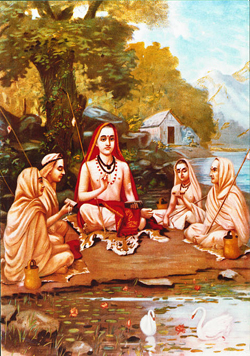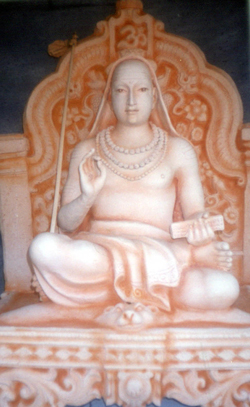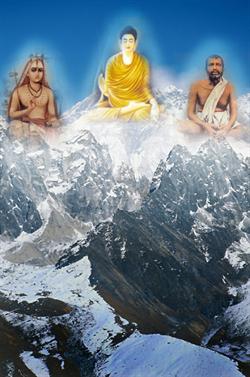Shankara – a life for God
 Approaching the teachings and life of the great yogi Shankara is every time, for every human being, a calling to meditation and at the same time a revelation of the depths of his soul. The entire life of Shankara was a continuous self-sacrifice towards God.
Approaching the teachings and life of the great yogi Shankara is every time, for every human being, a calling to meditation and at the same time a revelation of the depths of his soul. The entire life of Shankara was a continuous self-sacrifice towards God.
At the age of 10, he was a great scholar
Often considered the greatest philosopher of all times and a perfect yogi, Shankara, also called Shankaracharya, was born in Kaladi, in Kerala, the West coast of India, around 686. Historically talking, we know few things about him, but numerous fascinating legends reveal nevertheless some things from his austere life.
As a child, Shankara followed a Vedic school. He pierced the essence of the sacred Vedic teachings and formulated accurate definitions and profound analyses regarding those texts, thereby creating an entire synthetic philosophy. At the age of 10, he was already a great scholar. Not only did he read and memorize all traditional gospels, but he already wrote commentaries to many of them and presented them from a high level to the scholars that came from all the corners of the country, interested to see this wonder child who was considered an incarnation of Shiva.
However, the boy was unsatisfied. At the time when all children hardly start studying spelling, he already understood how superficial the knowledge of his time was. He saw that his teachers were not following the high and pure truths that they were preaching. Indeed the whole society that he lived in was mainly materialistic. India was passing through a period of spiritual decadence. Shankara, filled with ardor and spiritual self-sacrifice, felt in the depths of his being the calling of God and with maturity, ever since a child, he decided to make an example from his life that would guide people on the radiant path of Truth.
“Reflect over these things”
In that period, his father passed away. The boy was long time preoccupied to understand the problem of life and death. In his searches for the sense of existence, he renounced to almost everything that had a relative value. Then he wrote the poem Moha Mudgaraiu – “The shattering of the illusion”, in which he was asking: “Who is your wife? Who is your son? The roads of this world are strange, indeed. Whom do you belong to? Where do you come from? Vast is your ignorance, my dear! Because of this, reflect over these things and adore God.”
Shankara convinced his mother to let him take the monastic vow, promising her that he would return to see her before she dies. Then he left to pursue a genuine master.
 “He is my master”
“He is my master”
On the banks of the river Narmada, he met Gaudapada, a great yogi, who had reached the knowledge of the ultimate Reality. Shankara asks the old man to initiate him, but Gaudapada refused, because he had made a vow to remain continuously immersed in union with Brahman. Still he sent the boy to his most advanced disciple, Govindapada who initiated and instructed him in the meditating techniques and into the entire Yoga process. In a very short time, Shankara reached the complete spiritual achievement and decided to become a spiritual guide for the others.
One morning as he was going towards the Gange to take the ritual bathing, he met a chandala, a member of the lowest caste in India, the caste of those not to be touched. The man had four dogs that blocked Shankara’s way. For the first moment, the prejudices about the caste were recurring so, the Brahman ordered the chandala to get out of his way. However, the latter answered: “If there is only one God, how can there be so many kinds of people? How can there be so many differences and castes and beliefs?” The yogi was embraced by shame and respect. He prostrates himself filled with gratitude for the lesson received in front of that chandala. This incident inspired him later on to write one of the most beautiful poems, Manish Panchaka. It has five stanzas and each one ends with these verses: “The one who learns to see the Unique Existence everywhere; that is my master – no matter if he is a Brahman or a chandala”.
The base of his teachings
Complying with the instructions received from his guru – the mission to re-establish the Advaita Vedanta teaching as a place of confluence of all monastic and dualistic views, no matter how contradictory they may appear – the wise young man left to Varanasi, the old center of Vedic religion and culture, and started spreading the teachings about Unity placed in diversity. He had philosophical debates with scholars – leaders of different philosophical schools and established the supremacy of his way of thinking. Here he met the first of his four disciples, Sananda.
From Varanasi, the great spiritual master travelled to Bgarinath along with his disciples, giving the message of his philosophy to the people. He visited many holy places like Prayag, Hardwar, Rishikes, Srinagar, Rudrapayag, Nadapravag, Kamarupa and Gomukhi; he worshipped the gods he met on the way and thus he proved that an expert of Nirguna Brahman (transcendent God) is not without devotion Saguna Brahman (God seen in forms, deities etc.). There, in the quiet Himalayan heights, Shankara wrote comments to ten Upanishads, Bhagavad Gita and Brahma Sutras, and thus established his doctrine on a steady foundation.
The spiritual teaching revealed by Shankara is, from a strictly philosophical point of view, one of the most important and interesting ever born on Indian field.
He travelled as a pilgrim from one place to the other, engaging himself in discussions with leaders from the different cults and philosophical schools and through his unrivalled oratorical talent, sustained by a profound wisdom he continued to eliminate false dogmas and to destroy the untrue presumptions.
 The monastic orders founded by Shankara
The monastic orders founded by Shankara
Shankara travelled long ways and flatways four times over the vast subcontinent, establishing four principal monasteries in the four winds of India: Sringeri Math, on the hills Springers in the South, Saradha Math at Dvaraka in the West, Jyotiramath al Badarikasrama in the North and Govardhana Math at Puri in stand made his first four disciples as abbots of this monasteries. Also he assigned a Veda to be followed to each monastery thus: Rig-Veda for Govardhana Math, Yajur-Veda for Sringeri Math, Sama-Veda for Sarada Math and Atharva-Veda for Jyotir Math.
Shankara organized the whole monastic cult in India in ten well-woven orders (Dasanami Sampradaya). It is meaningful the fact that Sri Ramakrishna Paramahamsa, prophet of the modern India was the disciple of Swami Totapuri Maharaj, who belonged to the Puri line, one of the Dasanamis. This is why the monks of the Ramakrishna order are tied in a fundamental way to the great wise man Sri Shankara.
“This world is a paradise”
The earthly life of Shankara ended in Kedarnath, in Himalaya. He was only 32 years old. He was more of a reformer then an innovator; he did not preach a new doctrine or belief. He gave though a very strong creator impulse to the spiritual life from his time.
Shankara made the pure teaching of Vedanta to shine again after a period of backing because of the development of the Buddhism. He was considered a saint and the incarnation of Shiva. Separated by an interval of a thousand years, like three mountain peeks, Buddha, Shankara and Ramakrishna dominate lofty and serene the religious history of India. Shakara’s work is vast and sublime. He made comments not only about Vedanta Sutras, but he also created two major philosophical works: Upadeshasahasri and Viveka Chudamani (the spiritual judgement, the most valuable jewelry). He is also the author of many poems, hymns, prays and works referring to the Vedanta philosophy.
As his works proves, Shankara was more inclined to Jnana Yoga. He was though gifted with a great power of loving. Renunciation, Discrimination, Self-control, these were his key words. Shankara was not submitted to the illusion of this world, Maya. This is why he could so clearly describe the complete transformation of the Universe that takes place under the eyes of the liberated clear-sighted. When the communion with God is lived, when all the beings and phenomena are seen in the real relationship with God, then, says Shankara, “this world is a paradise”.
yogaesoteric
Also available in:
 Română
Română
